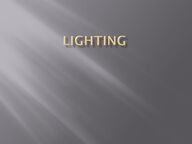
Return to flip book view
Direction Contrast Quality of Light Source Color (We discussed this in a previous class)
The art and craft of photographing moving objects on lengths of continuous film; the devices, procedures, and techniques used to achieve this. As is often said, cinematography is painting motion with light.
The Direction of the lighting creates the shadows. These shadows, or even lack of shadows, can have dramatic effects on the audience. The following slides discuss types of shadows and their potential effects on the audience.
Contrast is the range of tones between pure white and pure black. Low-contrast images have a wide range and appear soft to the eye, while high-contrast images have a small range and appear stark. There are bright highlights and dark shadows.
HIGH CONTRASTLOW CONTRAST
The quality of light is its perceived hardness or softness. A hard quality has dark shadows with sharp edges, while a soft quality has lighter, diffused shadows.
Often achieved through 3-point lighting Key Fill Backlight Video
The dramatic content of the scene dictates its brightness. Generally, you will find that high-key lighting is favored for upbeat scenes, and low-key lighting is the choice for slow or taut dramatic action.
High-key lighting means an overall brighter picture. Key light is strong, but soft; back and fill lights work together to create low contrast, greys instead of blacks and whites Often used in comedies and musicals
Low-key lighting means an overall darker picture. Often used in crime and horror shows Key light is much brighter than the fill light This is how you achieve chiaroscuro Shadows, extremely high contrast
Lighting for light/dark contrast. Creates volume and gives drama to a scene. The function of chiaroscuro lighting is realism, directional, spatial/compositional, thematic, and emotional.
Chiaroscuro Rembrandt Cameo Silhouette
Cameo lighting is chiaroscuro lighting to its extreme. The lighting is highly directional, has sharply defined cast shadows, and the background is unlit. It is used to have the viewer focus on a specific person or prop.
Silhouette lighting is the exact opposite of cameo. The background is lit, but the subjects are not. Silhouetted subjects have no volume or details. It is often used to make subjects appear in a dark mood.
Omnidirectional lighting from no particular singular source The major function of flat lighting is maximum visibility, though it can communicate thematic and emotional qualities. Sitcoms Talk shows
Source is where you see the light source in the screen (lights on table, window) Natural light is generally outside, sunlight or moonlight
Lighting Direction General Lighting Principles More Color Theory